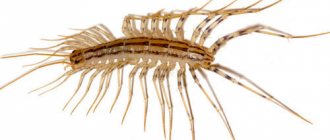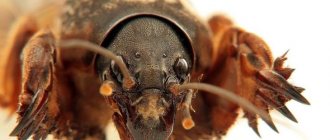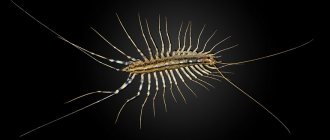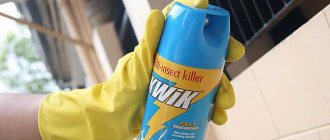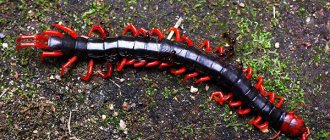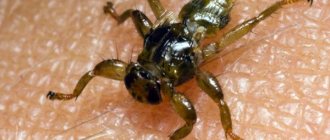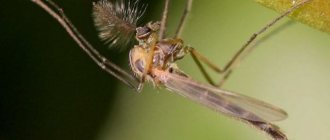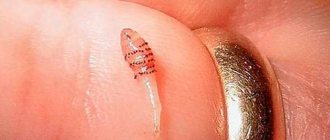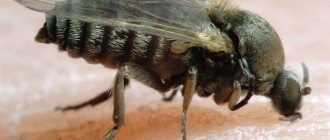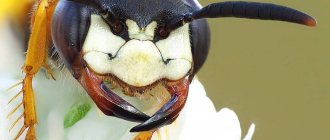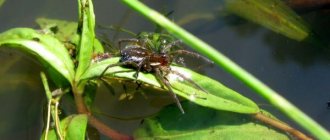To some people, flycatchers seem to be terrible creatures that can do a lot of harm. Others claim that these are the most useful creatures of nature and protect them. Let's figure out whether flycatchers are dangerous and what to do if you encounter them.
The common flycatcher is a predatory centipede of the genus Scutigera coleoptrata. It is also called the house centipede or the house centipede - it is important here not to confuse it with the real centipede, because there is a big difference between them.
The flycatcher hunts small insects and other arthropods, and does it very cleverly. Its diet consists of flies, midges, cockroaches, termites, two-tailed insects, moths, silverfish, spiders and other crawling and flying little things.
What does a flycatcher look like and where does it live?
The adult insect has an elongated, flattened body consisting of 15 segments. For each segment there is one pair of legs, the length of which increases from the head to the tail. The last pair of legs are so elongated that they look more like antennae (can be confused with the head). Due to the large number of long thin legs, scutigera looks like a hairy or shaggy centipede.
The first pair of legs are transformed into jaws, with which the centipede grabs prey and defends itself from enemies. When hunting, flycatchers inject poison into the body of the victim and then eat it. Flycatchers have good eyesight and a movement speed of up to 40 cm/sec. The antennae are whip-like, very long. The color is yellowish-gray or brownish, with three stripes along the body.
The flycatcher lives 3-7 years, growing up to 6 cm. You can distinguish an adult insect from a young one by the number of legs. The centipede that emerges from the egg has only 4 pairs of them. The number of legs increases after each molt, eventually reaching 15 pairs.
The range of flycatchers covers the distance from Southern Europe to North Africa. On the territory of Russia, it lives in the Black Earth Region, the Caucasus, Crimea and the Volga region.
Reproduction process
It is unusual that an arthropod such as the flycatcher can secrete pheromones and sounds that attract the opposite sex.
To deposit his spermatophore, the male weaves silk threads in advance for this purpose. The female, running through, shifts this sac inside with her genital appendages and fertilizes herself. During the warm period, eggs are laid in the ground and covered with a sticky substance on top. The average number of eggs ranges from 50 to 60 pieces.
When flycatcher eggs hatch, they have only 8 legs. Their number increases only after the next molt. At first there are 10 of them, then 14, 18, 26. After a few more molts, there are about 30 of them. Newborn arthropods resemble adults, but in a smaller version.
The female stays near the babies for about 14 days, protecting them from troubles and bird attacks.
What attracts flycatchers to a person’s home?
In nature, flycatchers live in fallen leaves; in the winter they crawl into places sheltered from the cold. They penetrate into human habitation mainly in the fall, due to the beginning of their passages. Room temperature is quite comfortable for these predators. In the house they choose dark places: spaces under the bathroom, basements, and continue to lead a predatory lifestyle - they catch all the insects they can find.
Color of males
In an adult male, the sides of the head and the upper part of the neck are brownish-gray or dark gray.
The rump and back are grayish-brown. The uppertail coverts are velvety black. The small flycatcher of the European subspecies has a large spot of bright red or buffy color on the crop, neck, and upper chest. The intensity of the spot color and its size depend on the age of the bird. It is larger and brighter in older males. From the neck, the gray color spreads to the sides of the breast and is bordered by a red spot along the edges. The lower part of the chest and lower tail coverts, belly are white. The underwing coverts are white to light buffy. The upperwings and primary wing coverts are brown. The central tail ones are black, the rest are two-colored: white at the base and black at the top. The beak is brown-brown, slightly lighter at the base of the mandible. Legs are brown-black. The iris of the eyes is brown.
Are flycatchers harmful?
The flycatcher is a useful creature that exterminates many insect pests. She is a real helper in the garden and vegetable garden. Therefore, if a flycatcher is found in the house during the warm season, it is better to carefully catch it with a jar or box (not with your hands!) and take it outside.
In the apartment, she does not damage the furniture and does not touch human food. She is only interested in insects, and in a few weeks she can clean an apartment of them no worse than a vacuum cleaner.
The flycatcher does not tolerate any diseases, does not attack humans or animals, and generally tries to stay away from all household members. Despite the fact that the insect is poisonous, its disposition is peaceful. If possible, she will not enter into conflict - she will simply run away. Of course, she can try to bite, but only in self-defense.
In southern countries, centipedes are welcome guests in gardens and fields; here they are protected and their contribution to the fight against agricultural pests is appreciated.
FIGHTING CENTIPODES WITH CHEMICALS
If you're not happy with centipedes just staying away from your home and you're going to eradicate them, read on.
If you have problems with centipedes only inside the house, you can sprinkle a powdered residual insecticide in places where flycatchers usually hide - cracks in the walls, dark corners in the basement, on the technical floor and under furniture. Keep in mind that centipedes will need to walk across the powder as they are predators, hunting for moving prey and not following bait.
You can discourage millipedes from hanging out outside your windows by treating the underside and soaking a strip of at least 5 feet wide around the house with a residual outdoor insecticide.
If you don't want to encounter centipedes even in your yard, also treat your lawn and the materials you use for gardening. But do not forget that the insecticide itself, separately from other measures, only works for a short time. If your yard, house or apartment is damp, littered and full of tasty insects, centipedes will happily return to you.
If you want to poison centipedes,
But you don’t want to poison relatives and pets; to constantly combat centipedes and insects, use natural pesticides such as boric acid or food-grade diatomaceous earth powder. Products containing plant pyrethrins are contact-active and can be sprayed as an aerosol.
What happens if a flycatcher bites?
Most often, the flycatcher fails to bite through the skin, unless we are talking about delicate children's or very thin women's skin. If she does manage to pierce the skin and inject poison, the bite will feel similar to a bee sting, and the symptoms will also be redness, burning, itching. The flytrap venom is not dangerous for people; it can only cause harm if there is an individual intolerance or an allergic reaction.
The flycatcher may try to bite domestic animals, defending itself from them. As in the case of a person, she will hardly be able to bite through their skin. But even if this happens, its bite and poison will not entail negative changes in the condition of the pets.
Much more dangerous than flycatchers are centipedes, another type of centipede with which, out of ignorance, they are sometimes confused. Although the scolopendra bite is not fatal to humans (with the exception of tropical species of scolopendra), it is very painful and can cause severe swelling that does not subside for several days. Scolopendra venom is especially dangerous for small children and can kill a cat or other small animal.
Prevention measures
Centipedes will not climb into houses where there is no dampness or food. There is no need to wait for the moment when these insects enter your home, but it is better to spend a little time and create unfavorable conditions for their life.
Preventive measures to prevent the appearance of flycatchers:
- Moisture should not accumulate in the bathroom, so it must be ventilated after bathing.
- Wring out wet rags. Do not leave them wet on the floor. Towels should be dried on devices designed for this purpose.
- Destroy the insects that the predator feeds on.
- You should regularly check the condition of pipes, drains in the bathtub and toilet, since high humidity is a favorable environment for the life of a flycatcher.
- Skirting boards must be tightly fixed. If there are gaps in the floor and around pipes running between floors, they should be filled with sealant.
- Systematically clean the toilet and bathroom - remove all debris and moisture, including in hard-to-reach places.
- Monitor the condition of basements and pipes. If necessary, call technicians to repair leaks and SES workers.
Remember that taking preventive measures is the best way to protect yourself from introducing centipedes into your home.
What to do if bitten by a centipede (flycatcher, centipede)
When bitten you need:
- Wash the wound with soap and water.
- Disinfect with any suitable means: for example, alcohol, vodka, cologne, boric acid or calendula tincture.
- Apply a cold compress for 40 minutes if the burning sensation is severe and swelling has formed.
- Take a pain reliever or antihistamine if necessary.
Next, you need to observe changes in your well-being. If alarming symptoms appear (severe malaise, nausea, confusion, vomiting), you should consult a doctor. As a rule, nothing like this happens.
In the case of scolopendra, everything is much more serious - the result can be severe swelling (if a limb is bitten, it will swell entirely), an increase in temperature and a sharp deterioration in well-being.
If you are bitten by a scolopendra, instead of a cold compress, you can apply a heating pad with a temperature of 45 °C. Under the influence of this temperature, the scolopendra venom is partially destroyed, and the person feels better. But still, in this case, it is better to immediately seek medical help, and if a child or small pet is bitten, it is imperative to seek help from a doctor.
Mosquitoes: guests for several days
It is difficult to imagine a person who would not know what mosquitoes look like. These insects appear in the house for a short time only to drink blood and fly back outside to lay eggs.
Only females are bloodsuckers (they need blood to produce eggs), but males, as a rule, feed on plant nectars.
The common mosquito, the most common biting parasite in our country (another name is the squeak mosquito, Culex pipiens):
And the next photo shows a malaria mosquito - an insect commonly found in the homes of people living in the tropics and carrying the corresponding disease. The photo shows how he holds his body - this is the main way to distinguish an anomaly mosquito from its ordinary counterpart:
The development of mosquitoes is always closely related to water, so houses with flooded basements are an ideal place for the breeding of these blood-sucking parasites. Also very often, these insects are found in private homes and cottages, where they always have an accessible source of moisture nearby.
Today there are a great variety of remedies for mosquito bites: these include ointments, creams, and various other forms of repellents. The main way to prevent these domestic insects from entering an apartment is mosquito nets attached to windows, as well as maintaining the basement and courtyard areas in good condition.
Why are people afraid of flycatchers?
The fear of centipedes and the hostility towards them on the part of people is explained mainly by two facts: disgust for their appearance and fear that they might get into the ear. The last statement is more related to the common myth about earwigs, which, according to some people, are able to get into the ear of a sleeping person, bite through the eardrum and penetrate the brain. Flycatchers are confused with earwigs, so they are just as feared.
In fact, neither the flycatcher nor the earwig has any intention of getting into human ears, much less capable of gnawing on the eardrum and brain. Besides, they don’t need it at all; they don’t feed on the brain.
It happens that small insects get into people's ears (most often these are flies, midges or cockroaches). Under no circumstances will a flycatcher climb into the ear canal - there is nothing attractive there for it and with its long legs it is completely inconvenient.
Report No. 2
In peat bogs in the light pine forests of North and South Carolina (USA), an amazing carnivorous plant from the Sundew family, the Venus flytrap, grows. It is interesting because it is a carnivorous plant. It catches small insects, slugs and spiders with a unique specialized trapping apparatus formed by the outer parts of the leaves. The sensitive hairs of the trapping apparatus react to any sustained movement, the trap slams shut and the digestion process begins.
Conditions of evolution
In a humid temperate climate, nutrients are not retained in the soil but are washed away. The plant always felt a lack of basic soil nutrition for successful growth and development, especially in relatively acidified soil there was a lack of nitrogen. Under such conditions, the plant could not synthesize enough proteins and develop normally. Therefore, in the evolutionary process, the flycatcher has developed the ability to hunt insects and replenish the required amount of nitrogen.
Hunting process
For a unique hunt, the flycatcher has adapted its very unusual leaves; it has from 4 to 7. The wide, bright green base of the leaf has all the conditions for nutrition from the roots and full photosynthesis. The area of the leaf that is involved in hunting is called the blade. It is located on the edge of the leaflet, consists of two narrow valves, with a longitudinal vein between them. Each valve has sensitive “trigger” hairs. Along the very edge there are teeth that completely intertwine when the trap is closed.
Parts of the trap painted red with special substances anthocyanins attract small insects and spiders. These same cells on the trap doors secrete a sweetish sticky secretion and prevent trapped insects from flying away. The more actively the insect tries to get out of the trap, the more sensitive hairs it will touch and the faster the doors will slam shut. The slamming happens very quickly in a fraction of a second. After the instant slamming of the trap, a half-hour phase of compressing the valves and sealing the victim begins.
Digestion
When the victim is sealed and cannot escape, the active release of digestive enzymes begins. During the digestive process, the trap is closed for 5 to 12 days. Digestive enzymes gradually dissolve the soft tissues of the insect and digest the prey. Large insects take longer to digest in the trap. The ideal conditions for flycatcher digestion are when the prey occupies one-third the size of the trap. Suction occurs quickly and the trap opens again. All that remains of the insect is its external skeleton, which is washed away by rain or blown away by the wind.
2, 3, 5, 6 grade
Flycatchers in the house - how to get rid of them
There are not many flycatchers in a living room, because this is an unusual habitat for them, and they are unlikely to breed in an apartment. Therefore, flycatchers can be easily caught and sent outside.
If you decide to get rid of flycatchers in your apartment using radical methods, that is, destruction, you need to take into account the peculiarities of their nutrition, body structure and behavior. For example, if sticky traps are removed, they are ineffective in combating insects - the insect tears off the stuck legs and runs away. Baits for cockroaches and ants also have no effect on them, because flycatchers are predators; they feed on live insects.
You can kill a flytrap with any hard object, boiling water or insecticide (it’s more convenient to use sprays). Any insecticide will do; flycatchers are not resistant to them.
You can make the flycatchers leave the apartment on their own. For example, if you get rid of all the insects in the apartment, they will have nothing to eat and will have to go in search of a more suitable place.
They love humidity, so you can often encounter them in the bathroom. If you do not allow moisture to accumulate in the bathroom and ventilate it regularly, the flycatchers will soon become uncomfortable here and will leave.
You can block access to the house for flycatchers, as well as various insects, by caulking all the cracks in the walls, floor and basement, as well as installing mesh on the ventilation outlets.
Care
Feeding
The most difficult, and at the same time fascinating process is feeding the plant. Fertilizers cannot be used to avoid this procedure; Dionaea is a predator, and it receives all its nutrients from insects. Suitable food sources include spiders, flies, small cockroaches and mosquitoes. If a large insect (such as a cockchafer) gets into the trap, the trap will not be able to digest it. And then it turns black and dies; it must be carefully trimmed.
Digestion of food takes the flycatcher from 10 days to two weeks. Only when the trap opens completely does it mean it is ready to eat. The question always arises: where to get live insects for feeding?
- In summer, you can take the plant out onto the terrace; the smell of nectar will attract food. You just need to make sure that large insects do not fall into the traps;
- Some people raise flies from maggots, which are found outdoors in rotting meat or fish. But this procedure is not suitable for everyone, just like growing mosquitoes from bloodworms;
- Sometimes in a garden plot they lay out adhesive tape not far from the anthill, and catch the ants with tweezers in a jar;
- You should not feed the flycatcher if the plant is weakened by disease or after transplantation.
The traps are fed with tweezers by dropping a fly or ant into the trap. During the entire growing season of Dionea, 3 flies or large mosquitoes are enough.
Watering
The Venus flytrap is not watered, it is given water in a tray, and through the holes in the pot it flows into the roots. Most importantly, the water should be rainwater (of course, not from a dirty city roof) or distilled
It is very important for the plant that the water is as soft as possible. During the active growth stage, water at least three times a week.
Check the soil for moisture every day. Drying out the earthen coma is detrimental to the exotic plant. Choose a pot for the plant that is tall and has a small diameter, since the roots of the Venus flytrap are long. In nature, the plant lives in flooded meadows or peat bogs, where there is a lot of underground water. Therefore, it does not need watering from above. Water can get into the traps and damage them.
Lighting
The most favorable location for a predatory flycatcher in an apartment is south-eastern and south-western windows. The plant should receive at least 6 hours of light in the morning and the same amount in the evening. If the plant is planted in a florarium, which provides high humidity, artificial lighting may be needed. A 40-watt lamp is placed at a height of about 25 cm, depending on the size of the plant, and left on for 15 hours.
In summer, Dionea can be taken out to a balcony or open loggia, but care must be taken to ensure that the flower is not exposed to direct sunlight. For proper development, the plant needs light, but everything needs moderation. There is no need to rotate the pot as you do with other plants - the Venus flytrap does not like to be disturbed.
Temperature
In summer, the optimal temperature for the plant is from 20 to 30 degrees Celsius. Therefore, you can easily take it to the warm side of the veranda or terrace. In winter, during the rest period, the temperature is reduced, but not below +8 degrees.
Humidity
The Venus flytrap loves humid air of 50-70%, but this is difficult to achieve without spraying. It’s good if it is planted in a florarium, natural humidity is maintained there. She also doesn’t like stagnant air, but drafts are also contraindicated for her. Ventilate the room as needed, but not for long. If it grows in a pot, then you can put a bowl of water. The evaporation will moisten the dry air of apartments directly near the flower.
The soil
The most suitable substrate should correspond to natural conditions and consist of:
- 4 parts sour peat (better to buy at a flower shop);
- 2 parts perlite, soaked in water for a week;
- 1 part coarse river sand (boiled in distilled water).
Transfer
An adult plant is replanted only in a healthy state in the spring. This procedure is carried out once a year, after wintering.
When replanting, care must be taken, since the roots are very fragile, any damage to the roots leads to difficulties for the plant to take root in a new place.
Using the transshipment method, remove the root system and clean it of old soil. If it is difficult to separate, soak the roots in water and then rinse with a spray bottle. After transplanting into a new pot, the plant will need about a month to adapt, so the transplanted flower should be protected from bright sunlight and watered more often.
Interesting behavior
The flycatcher makes good use of its long legs. Can move at alarming speeds - the equivalent of over 64 kilometers/hour in human terms. This will scare even the most die-hard arthropod lover. Athleticism doesn't have to scare you. The house flycatcher is simply well equipped to stalk and catch prey.
Oddly enough, the severed leg will continue to move for several minutes after its owner leaves the stage. They shed even as adults and regenerate lost limbs.
They feed on spiders, bedbugs, termites, cockroaches, silverfish, ants, and other domestic arthropods. The poison is secreted through the forcipules. Not through the lower jaw, so they burn and do not bite. These are night hunters.
Despite their developed eyes, they rely on their whiskers to hunt. The antennae are sensitive to both odors and tactile information. They use mandibles and legs to hold prey. Thus, they can deal with several small insects at the same time.
To catch prey, they either jump on it or use their legs in a technique described as a "lasso". The use of legs to subdue prey is also described.
We suggest you read: How do worms get out of the human body?
They have adapted their feeding pattern to the type of danger the prey may pose to them. For wasps, retreat after applying the poison to give it time to take effect.
Danger level
There is a big difference between the concepts of “scary” and “dangerous”.
A centipede in an apartment is not at all dangerous. However, everyone is afraid of her, so they attribute to her properties that she does not possess. It is truly poisonous, but this poison is aimed at quickly immobilizing its food, that is, arthropods. Large animals like humans are of no interest to her. Man, of course, is dangerous to the flycatcher itself, but this centipede does not use its poison against him. This is probably too irrational. She prefers to hide from animals that are dangerous to her in all sorts of shelters, fortunately this is easy for a flat creature to do. The domestic centipede is not dangerous for humans because it cannot bite him. Moreover, she is not going to do this. The only possible danger is that a person can crush it, then the flycatcher will try to defend itself. If the centipede turns out to be large, and the human skin at the point of contact is tender, then there is a possibility of biting through the surface of the skin and injecting poison.
This happens extremely rarely. We can say that this is more a hypothesis than reality. However, what to do if the flycatcher still bites? First of all, do not panic, do not look for an antidote (there is none anyway), do not prepare for the worst.
The consequences of a centipede bite can be compared to bee or wasp stings. For humans, this can only pose a danger in the event of an allergic reaction, which has not been recorded in the history of medicine.
So, if a flycatcher was able to bite you, then you need to do the following:
- put something cold on the bite site to eliminate pain and burning;
- lubricate the swollen area with Zvezdochka balm;
- apply a compress of vodka, grated raw potatoes, clay, aloe leaf or kalachoe;
- apply an iodine grid.
You don't have to do everything at once. Listed here are different options for relieving pain, relieving swelling, and accelerating the resorption of poison. In most cases, you don’t need to do anything - disinfect the wound with iodine and wait for it to go away on its own. You won't have to wait long.
It should be remembered that if a flycatcher bites, then people are primarily to blame for this. After all, this little booger is not even able to see a person. She sees only a hand, some movement of something large and warm. This centipede doesn’t even always associate humans with danger—many have noticed how this original creature sits, spread out on the wall, not suspecting what passions are seething around its small body about this.
